Introducing the History of Mathematics: An Italian Experience Using Original Documents
Many Italian mathematics teachers are interested in the history of mathematics but very few use it in their classrooms. Why is this? In our opinion, they consider the history of mathematics to be merely a “beautiful story” but don’t have time in their classrooms for stories. They must concentrate on improving their students’ mathematical skills and understanding. The history of mathematics offers many opportunities for doing mathematics and improving student problem solving skills. Unfortunately, our teachers rarely have the didactical resources to utilize these kinds of activities.
In order to remedy this situation, a collaborative effort to produce suitable materials was established between GREMG, Department of Mathematics, the University of Genoa and IPRASE, Trento, [Provincial Education Research Institute, Trento.] I led a team of consultants and writers including five in-service teachers on this task. Much assistance and encouragement was provided by Prof. Fulvia Furinghetti, Department of Mathematics, University of Genoa. Our goal was to produce a set of historical based activities that could be included into daily classroom instruction. Their integration into the curriculum is intended to promote alternate ways of teaching based on working with historical excerpts and exercises chosen to reinforce (or sometimes even introduce) mathematical competencies.
A two year cooperative effort resulted in the publication of the book: Fare mathematica con i documenti storici. [Doing mathematics with historical documents], 2006, pp168, Adriano Demantté, editor.
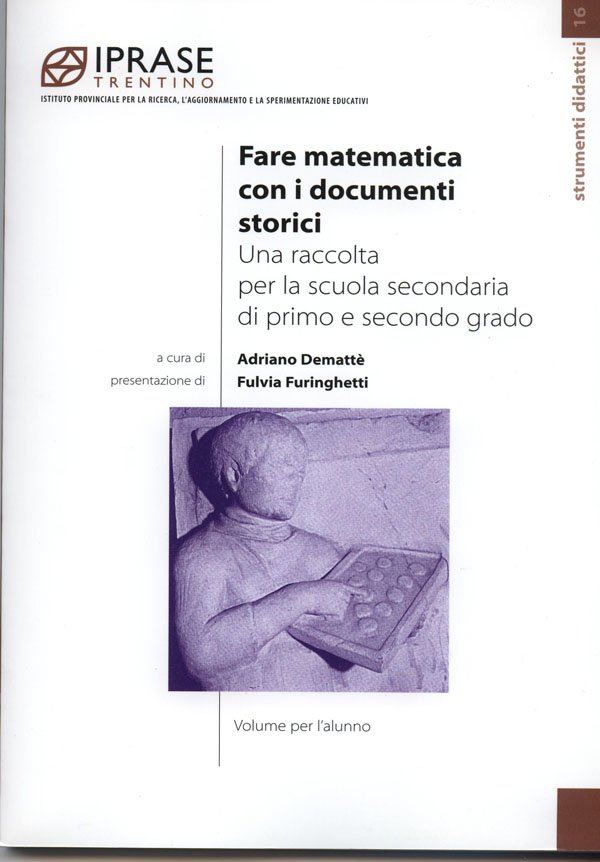
A companion text, Volumi per gli insegnanti [Volume for Teachers], provides teaching suggestions, answer keys, topics for further study and bibliography. The student text is comprised of selected documents chosen to expose the work of many important historical authors and also to consider less famous mathematicians whose works were representative of their times. Important Italian secondary school topics are considered. Questions and activities follow after every document. Their role is to focus student attention to the main points in the original document, involving her/him in an active way. The “doing of mathematics” is stressed. Some questions led to further exercises and problems, using different examples or recalling themes in mathematics textbooks. Sometimes students are required to conjecture about the causes of certain historical developments. Teachers using these books can find topics for student discussion and further explorations in mathematics.
Introducing the History of Mathematics: An Italian Experience Using Original Documents - Introduction
Many Italian mathematics teachers are interested in the history of mathematics but very few use it in their classrooms. Why is this? In our opinion, they consider the history of mathematics to be merely a “beautiful story” but don’t have time in their classrooms for stories. They must concentrate on improving their students’ mathematical skills and understanding. The history of mathematics offers many opportunities for doing mathematics and improving student problem solving skills. Unfortunately, our teachers rarely have the didactical resources to utilize these kinds of activities.
In order to remedy this situation, a collaborative effort to produce suitable materials was established between GREMG, Department of Mathematics, the University of Genoa and IPRASE, Trento, [Provincial Education Research Institute, Trento.] I led a team of consultants and writers including five in-service teachers on this task. Much assistance and encouragement was provided by Prof. Fulvia Furinghetti, Department of Mathematics, University of Genoa. Our goal was to produce a set of historical based activities that could be included into daily classroom instruction. Their integration into the curriculum is intended to promote alternate ways of teaching based on working with historical excerpts and exercises chosen to reinforce (or sometimes even introduce) mathematical competencies.
A two year cooperative effort resulted in the publication of the book: Fare mathematica con i documenti storici. [Doing mathematics with historical documents], 2006, pp168, Adriano Demantté, editor.

A companion text, Volumi per gli insegnanti [Volume for Teachers], provides teaching suggestions, answer keys, topics for further study and bibliography. The student text is comprised of selected documents chosen to expose the work of many important historical authors and also to consider less famous mathematicians whose works were representative of their times. Important Italian secondary school topics are considered. Questions and activities follow after every document. Their role is to focus student attention to the main points in the original document, involving her/him in an active way. The “doing of mathematics” is stressed. Some questions led to further exercises and problems, using different examples or recalling themes in mathematics textbooks. Sometimes students are required to conjecture about the causes of certain historical developments. Teachers using these books can find topics for student discussion and further explorations in mathematics.
Introducing the History of Mathematics: An Italian Experience Using Original Documents - Contents of Students' Volume
As a brief introduction to the content and format of Fare mathematica some excerpts are given in English translation:
The Table of Contents from the Students’ Volume:
CONTENTS
Preface by Fulvia Furinghetti
.
Introduction for students.
CHAPTER 1: FROM ARITHMETIC TO ALGEBRA - Numeration: Egyptians; Babylonians; Greeks; Romans; Mayas; Indians, at last; Who invented binary numbers? - Operations and non-negative integers: Middle Ages and Renaissance - Not only non-negative numbers: Fractions in Egypt: the Horus’ eye; How Egyptians wrote fractions; Decimals and Arabs; Decimals in Europe - The arithmetic triangle: Chinese, Arabs, Europeans… - Curious problems: Let’s solve together; Other problems: the text; Other problems: the solutions - “False” numbers: In sixteenth-century Italy; A woman grapples with mathematics - From words to symbols: A great Arabian mathematician; Diophantus left a mark; All of them are equations; A “recipe” to solve an equation; The science of “literal calculus”; Philosopher, physician and… mathematician - Problems and equations: Linear and quadratic problems - Bombelli and the number i: Is it a number? - Logarithms: An ancient idea; An authoritative answer - And more… evolution of symbols.
CHAPTER 2 – FACES OF GEOMETRY - Arithmetic and geometry: figurate numbers: Polygonal numbers; Pythagorean terns; Ingenious ways to obtain Pythagorean terns - Pythagorean theorem: A walk through history: sides and squares…; … a problem in the Renaissance…; …problems and equations - Far points: About towers and other buildings; How to bore a tunnel and not come out in the wrong place - Square root of 2: How did they do it? - pi: What is the true value? - Archimedes: A volley of propositions; The area of the circle and the method of exhaustion - Cartesian coordinates?…: In the fourteenth century; One of the fathers - Geometry, of Euclid and not: An authoritative introduction, but…; The Elements: almost a Bible; Two millennia later - Trigonometry: From a sixteenth-century book - What is topology?: A new geometry; The problem of Königsberg’s bridges; The explanation of Euler - And more… solid numbers.
CHAPTER 3: THEMES OF MODERN MATHEMATICS - Logic: an ancient but current science: What are logical connectives?; The art of… reasoning; Mathematics takes possession of logic - Logic to build numbers: Gottlob Frege and Bertrand Russell - Let’s measure uncertainty: Galileo and a problem about the casting of three dice; Epistolary interchanges; The classical conception of probability; Other conceptions of probability - Infinity: Runners, arrows, hares, tortoise,…; The whole is not greater than the part; Infinite is a source of other paradoxes; Let’s arrange our knowledge - Cantor’s paradise: Real numbers are more than integers; Cantor in Hilbert’s opinion - Infinitesimals before Newton: The circle; The torus; The indivisibles - Limits, derivatives, integrals (I’m sorry if it is too little): Isaac Newton - We don’t stop… history continues…
Introducing the History of Mathematics: An Italian Experience Using Original Documents - Sample Excerpt
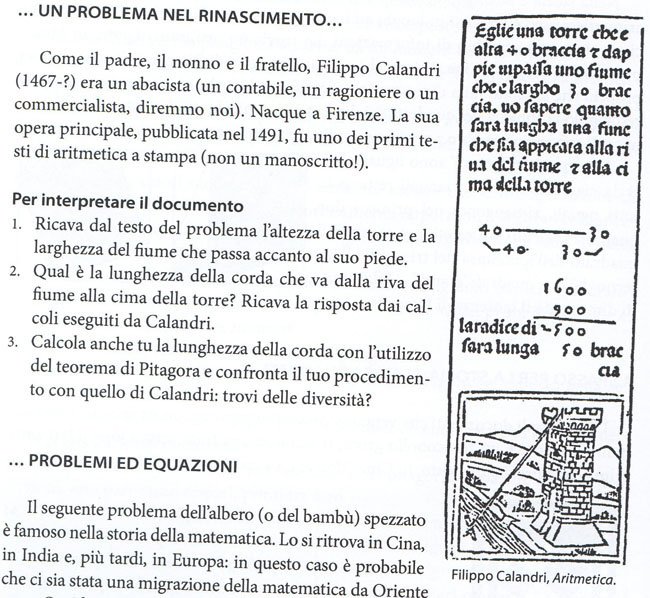
Translation:
There is a tower that is 40 ells high and near the base flows a river that is 30 ells wide. We want to know how long a rope is that starts from the riverside and ends at the top of the tower.
… A PROBLEM IN THE RENAISSANCE…
Like his grandfather, father and brother, Filippo Calandri (1467-?) was an abacist (a book-keeper, an accountant or a business expert as we would say). He was born in Florence. His masterpiece published in 1491 was one of the first printed arithmetic books (not a manuscript!).
To interpret the document
- In the text of the problem find both the tower height and the width of the river flowing near the base of the tower.
- What is the length of the rope that starts from the riverside and ends at the top of the tower? Find the answer in Calandri’s calculations.
- Calculate the rope length by means of the Pythagorean theorem and compare your procedure with Calandri’s procedure: do you find any differences?
Discussion from the teachers' volume:
… A PROBLEM IN THE RENAISSANCE…
Calandri’s problem about the rope length provides an opportunity to interpret a primary mathematical source to students who have a certain ability in numerical applications of the theorem. Students will be able to deduce the meaning of some words from the context. Other words may remain obscure but this shouldn’t impede analysis of the rest of the document. The figure will also help find both the data and the answers of the problem. We may give the student complementary notes on the lack of operation symbols (in the part that concludes the first chapter you can find information about when addition, subtraction, and square root symbols entered common use).
Introducing the History of Mathematics: An Italian Experience Using Original Documents - Pythagorean Theorem (Italian)
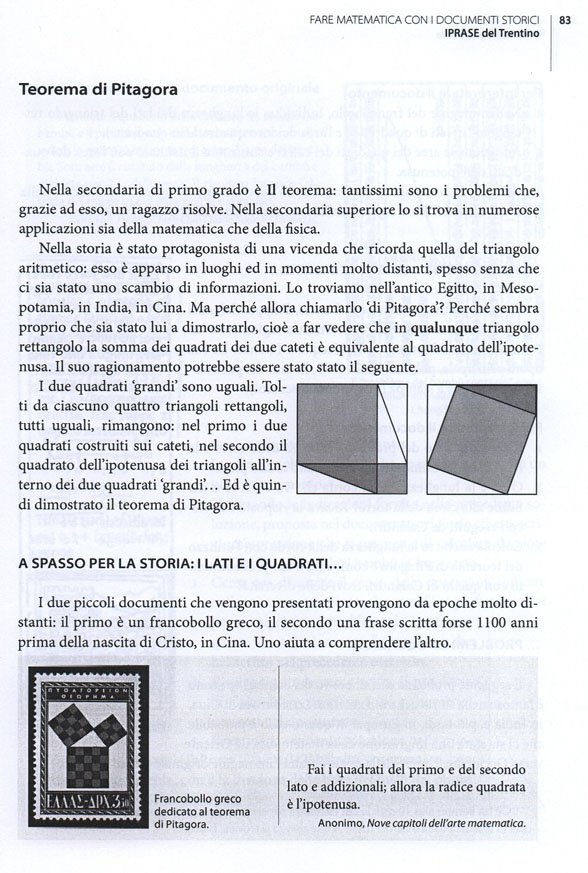
Introducing the History of Mathematics: An Italian Experience Using Original Documents - Pythagorean Theorem (English)
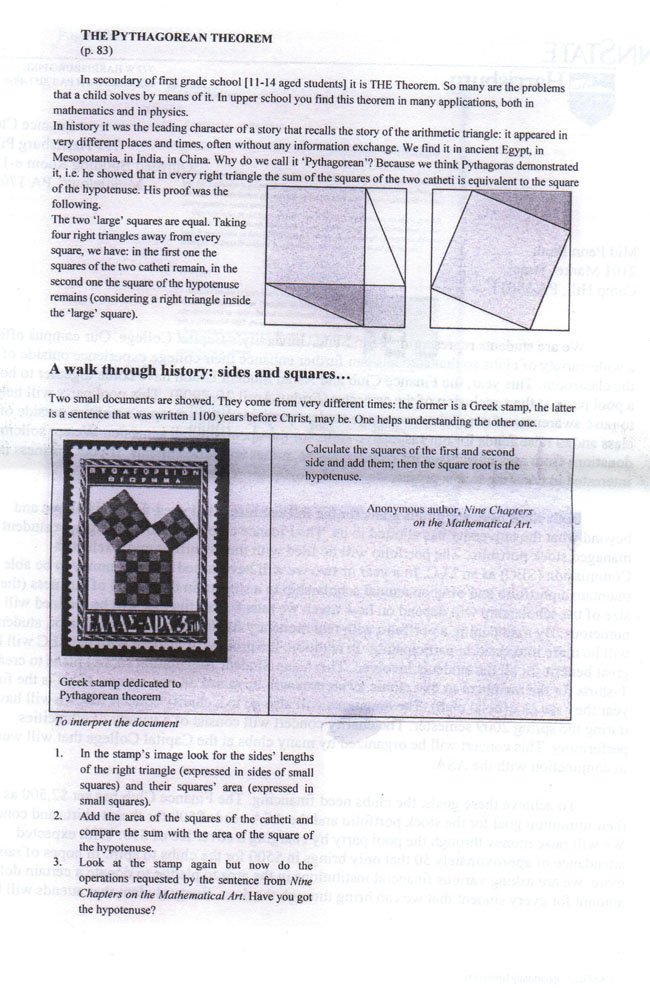
Introducing the History of Mathematics: An Italian Experience Using Original Documents - An Italian Excerpt
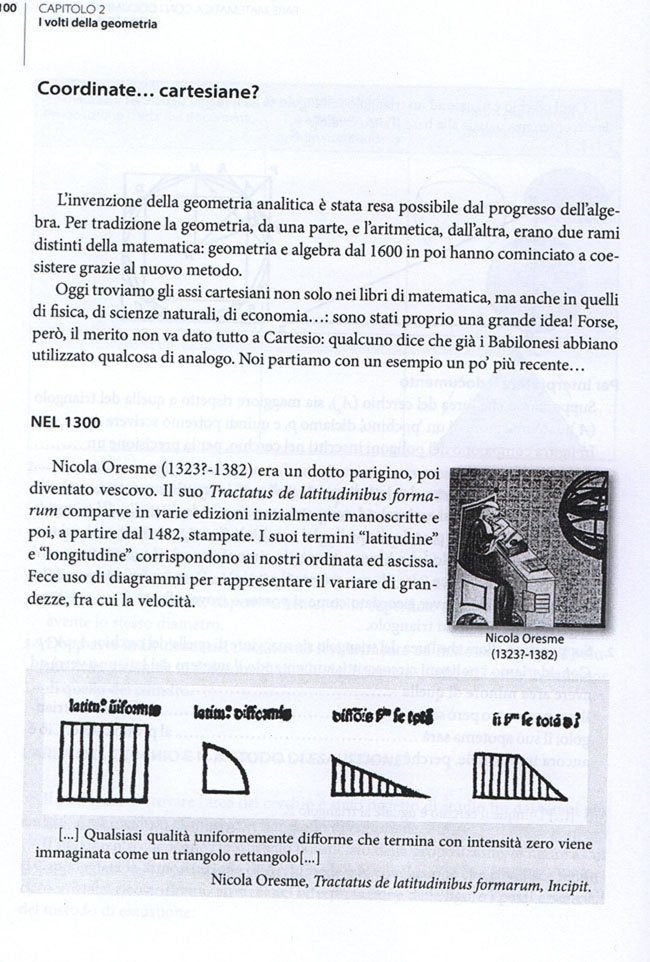
Introducing the History of Mathematics: An Italian Experience Using Original Documents - A Final Excerpt
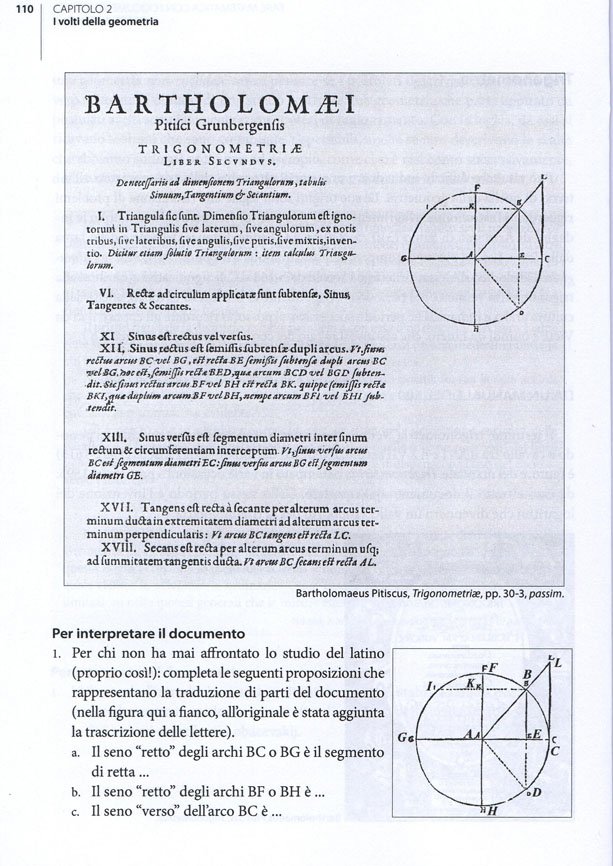
Introducing the History of Mathematics: An Italian Experience Using Original Documents - Further Information
To request a copy contact: Antonella Fambri antonella.fambri@iprase.tn.it
Centro di Documentazione Scolastica – IPRASE del Trentino